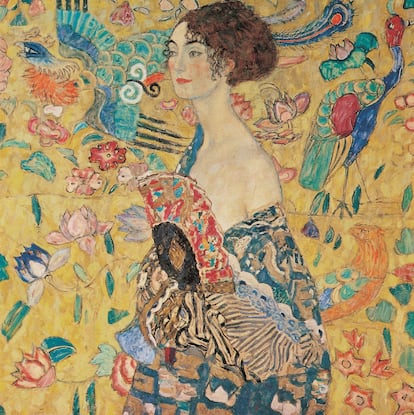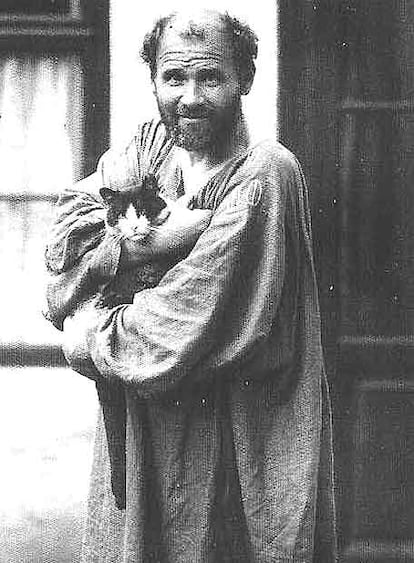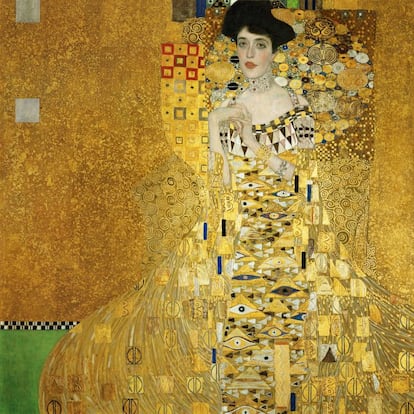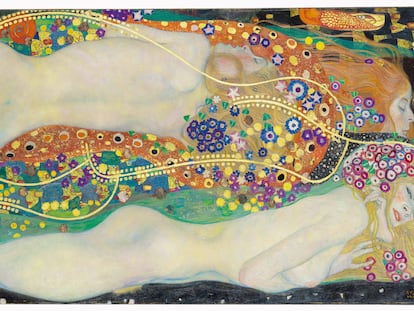Gustav Klimt, a record-breaking painter who symbolizes the looting of Jewish art by the Nazis
Works by the Viennese creator have attained astronomical prices at auction. But the true value is in the symbolism of his paintings, which were stolen from Jewish families by the Nazis

The art market is money. And, behind the checks, you can even hide your past. Some of the best canvases by Austrian painter Gustav Klimt (1862-1918) have sold in recent months for more than $100 million. However, these amounts — which have broken records in the art market — have hidden their most authentic value: the paintings’ relationship with the Nazi persecution of the Jews and the Holocaust.
This past June 27, when Patti Wong — former president of Sotheby’s Asia auction house — sold Klimt’s Lady with a Fan (1917-1918) to a Hong Kong-based client for $108.4 million, the art world instantly declared that it was the most expensive work ever sold in Europe. This was the last painting by the artist, who was still at the easel when he died of a stroke in 1918. Last year, Klimt’s Birch Forest — from the collection of Paul Allen, a co-founder of Microsoft — was auctioned off for $104.5 million.
Before these sales, back in 2021, France returned the Viennese artist’s Rosebushes under the Trees to the descendants of its original owners. For years, it hung in the Musée d’Orsay, in Paris. A special authorization from the French Parliament was required to turn this painting over, as it was considered to be the “inalienable” property of the French state. It was the government’s only Klimt. However, everyone understood who the painting truly belonged to, and the terror in which it was lost. The work had been inherited by Nora Stiasny, a Jewish woman who had to sell it for next to nothing after Austria was annexed by Germany, so that she and her family could survive. Deported to occupied Poland in 1942, that same year, she died along with her son and her husband.

Despite the fact that Austria has made it very difficult to return looted art, someone always appears to fight for justice. Anyone who knows Ronald Lauder — president of the World Jewish Congress and head of cosmetics conglomerate Estée Lauder — knows that he has three obsessions: art, restitution and the Holocaust. He is polite, honest and tough. In 2006, after six years of legal battles, the Austrian government had to return five Klimt paintings to the descendants of Adele and Ferdinand Bloch-Bauer. The most famous, Portrait of Adele Bloch-Bauer I (1907), was bought from her heirs by Lauder. He paid $125 million dollars for the piece. The “Mona Lisa of Austria” subsequently moved to the United States.
Last March, the tycoon repurchased a Klimt painting he had acquired in 1973. He had bought The Black Feathered Hat, despite the possibility that it had been looted. The work — exhibited in his Neue Galerie in Manhattan — originally belonged to the family of Irene Beran. Several members of her family were murdered by the Nazis in the Theresienstadt concentration camp, which was set up in what today is the Czech Republic. This was enough for Lauder to properly compensate the surviving members of the family. Meanwhile, in 2006, another Bloch-Bauer portrait sold at Christie’s for $87.9 million.
Without these truths, the paintings would only be decorative portraits of the Viennese gentry (many of them Jews) from the late-19th and early-20th century. The concealment of the looting that took place is part of the reason for their mythical status. It wasn’t until 1986 that a journalistic investigation revealed that then-Austrian President Kurt Waldheim (1918-2007) had lied about his role in World War II and knew more about Nazi behavior than he admitted. This was the end of the myth of Austrian victimhood.
At 5:00 a.m. on March 13, 1938, Hitler’s troops crossed the German border and invaded Austria (it was called the Anschluss, or union). They were greeted with cheers and flowers; not a shot was fired. Nobody was scared — except for the 200,000 Jews who lived in the country of 6.5 million people. It was the first act of Nazi “aggression,” in direct violation of the Treaty of Versailles and the Treaty of Saint-German. Signed in the aftermath of World War I, they expressly forbade Germany from annexing Austria. But the international community did nothing to stop the Anschluss. Soon after, Hitler would be received in Linz — where he planned to erect the Führermuseum — and Vienna, the capital.
The arrival of the Nazis sparked violence and robbery against Jewish Austrians. Gallerists, art dealers and even neighbors stole their possessions. They beat them, attacked them, humiliated them. The infamous “scrubbing parties” (Reibpartien) became popular: the Nazis forced the Jews of Vienna to clean public toilets and streets amid the jeers of the crowds. Some managed to escape. An exit visa could be obtained by a Jew in exchange for selling off all of their properties. But this didn’t last for long. The Gestapo — quickly installed in Vienna — soon began to “hunt” Jews. This was the suffering endured by some Jewish families, such as the Stomborough-Wittgestein or Bloch-Bauer families, whom Klimt had portrayed two decades earlier.
Austrian historian Tobias G. Natter — an expert in the Viennese Art Nouveau period — considers Klimt to be a key figure of this time. Not only did he co-found secessionism — a combination of decorative geometry and abstraction — but he is also a symbolic figure of the turn of the century in the city. His body of work goes hand-in-hand with Sigmund Freud’s psychoanalysis, interpretation of dreams and the discovery of sexuality, as well as the musical innovations of the composer Arnold Schönberg.

Klimt’s production was scarce: he only did about 250 paintings — what Picasso created in a year. “He had the support and commissions of the enlightened and cosmopolitan Jewish bourgeoisie, especially as a portraitist,” explains Ivan Ristić, curator of the Leopold Museum in Vienna. “He had, in particular, two models: Margaret Stonborough-Wittgenstein (sister of the famous philosopher) and Adele Bloch-Bauer.” The story in the margins is that Klimt turned the women he portrayed into his lovers. The painter never married. He had 14 children, only recognizing three of them.
Buying a Klimt has a depth that carries an echo of robbery and murder. Art historian Lynn Nicholas wrote: “After the Anschluss, the scale of plunder against the Jews went far beyond what had by then occurred in Germany.” The Nazis erased all degenerate art from public collections and sold it through auction houses, such as the Dorotheum. “The Nazi regime claimed countless lives, tore families apart and robbed them of hope for a prosperous future,” laments Peter Weinhäupl, director of the Klimt Foundation. “In addition, as these expropriations were carried out, many extraordinary collections were destroyed, including paintings and drawings by Klimt. But they went further. The Nazis even went so far as to instrumentalize his work for their own purposes, such as the 1943 Vienna Secession exhibition, then known as Ausstellungshaus Friedrichstraße, commissioned by Nazi leader Baldur von Schirach.” Von Schirach was sentenced to 20 years in prison in Spandau after the Nuremberg trials. He died a free man in 1974.
This is all a part of Klimt’s legacy. The beauty of his paintings, the shine of the gold leaf he used, or the silver sheets aren’t able to hide the fate of the people he portrayed and those who bought his works, even 78 years after Nazism. His work is a tribute to more than six million murdered Jews. A true accounting of the horror.
Sign up for our weekly newsletter to get more English-language news coverage from EL PAÍS USA Edition
Tu suscripción se está usando en otro dispositivo
¿Quieres añadir otro usuario a tu suscripción?
Si continúas leyendo en este dispositivo, no se podrá leer en el otro.
FlechaTu suscripción se está usando en otro dispositivo y solo puedes acceder a EL PAÍS desde un dispositivo a la vez.
Si quieres compartir tu cuenta, cambia tu suscripción a la modalidad Premium, así podrás añadir otro usuario. Cada uno accederá con su propia cuenta de email, lo que os permitirá personalizar vuestra experiencia en EL PAÍS.
¿Tienes una suscripción de empresa? Accede aquí para contratar más cuentas.
En el caso de no saber quién está usando tu cuenta, te recomendamos cambiar tu contraseña aquí.
Si decides continuar compartiendo tu cuenta, este mensaje se mostrará en tu dispositivo y en el de la otra persona que está usando tu cuenta de forma indefinida, afectando a tu experiencia de lectura. Puedes consultar aquí los términos y condiciones de la suscripción digital.
More information
Archived In
Últimas noticias
Most viewed
- Sinaloa Cartel war is taking its toll on Los Chapitos
- Oona Chaplin: ‘I told James Cameron that I was living in a treehouse and starting a permaculture project with a friend’
- Reinhard Genzel, Nobel laureate in physics: ‘One-minute videos will never give you the truth’
- Why the price of coffee has skyrocketed: from Brazilian plantations to specialty coffee houses
- Silver prices are going crazy: This is what’s fueling the rally










































